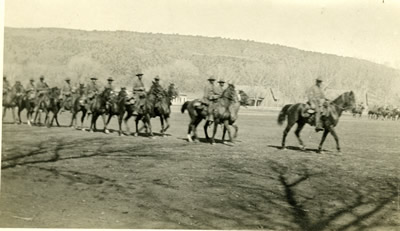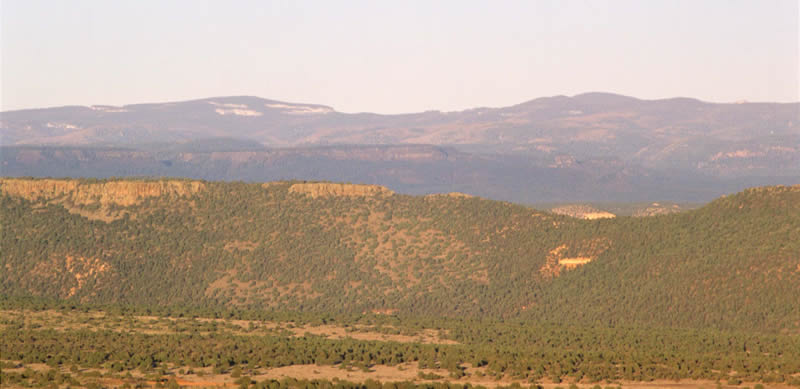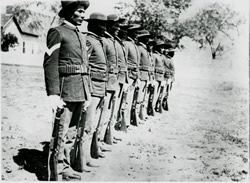 |
In July 1869 Brevet Colonel (Major) John Green of the U.S. 1st Cavalry led a scouting expedition of more than 120 troops into the White Mountains area from Camp Goodwin and Camp Grant to the south. Seeking to kill or capture any Apache people they encountered, the expedition headed north up the San Carlos River, across the Black River, and to the White River in the vicinity of the future site of Fort Apache.
Army scouts reported finding over 100 acres of cornfields along the White River. Escapa--an Apache chief that the Anglos called Miguel--visited the camp, and invited Col. Green to visit his village. Green sent Captain John Barry, urging him “if |
possible to exterminate the whole village.”
When Captain Barry arrived at Miguel's village, however, he found white flags "flying from every hut and from every prominent point," and "the men, women and children came out to meet them and went to work at once to cut corn for their horses, and showed such a spirit of delight at meeting them that the officers [said] if they had fired upon them they would have been guilty of cold-blooded murder."
Green returned to the White Mountains in November, and met again with the Apache leaders Escapa (Miguel), Eskininla (Diablo), Pedro, and Eskiltesela. They agreed to the creation of a military post and reservation, and directed Green to the confluence of the East and North Forks of the White River:
I have selected a site for a military post on the White Mountain River which is the finest I ever saw. The climate is delicious, and said by the Indians to be perfectly healthy, free from all malaria. Excellently well wooded and watered. It seems as though this one corner of Arizona were almost its garden spot, the beauty of its scenery, the fertility of its soil and facilities for irrigation are not surpassed by any place that ever came under my observation. Building material of fine pine timber is available within eight miles of this site. There is also plenty of limestone within a reasonable distance.
This post would be of the greatest advantage for the following reasons: It would compel the White Mountain Indians to live on their reservation or be driven from their beautiful country which they almost worship. It would stop their traffic in corn with the hostile tribes, they could not plant an acre of ground without our permission as we know every spot of it. It would make a good scouting post, being adjacent to hostile bands on either side. Also a good supply depot for Scouting expeditions from other posts, and in fact, I believe, would do more to end the Apache War than anything else.
The following spring troops from the 21st Infantry and 1st Cavalry were ordered to establish "a camp on the White Mountain River ." |
| On May 16, 1870 they began construction of Camp Ord. Over the course of the next year, the remaining troops at Camp Goodwin moved to the site, and the camp would be renamed Camp Mogollon, then Camp Thomas , and finally, Camp Apache . The post was designated Fort Apache in 1879.
The Army abandoned Fort Apache in 1922. In 1923 the site became the home of the Bureau of Indian Affairs’ Theodore Roosevelt Indian Boarding School . First intended to serve Diné (Navajo) children, by the 1930s a majority of students at the school were Apache. Today T.R. School continues to serve as a middle school, under the administration of a school board selected by the Tribal Council. |
|


